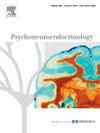Longitudinal association between plasma epidermal growth factor and the progression of anxiety and depressive symptoms in Parkinson's disease
IF 3.6
2区 医学
Q2 ENDOCRINOLOGY & METABOLISM
引用次数: 0
Abstract
Objective
Parkinson's disease (PD) is marked by a high incidence of neuropsychiatric symptoms that significantly impact the patients' quality of life. Biomarkers for monitoring anxiety and depressive symptoms in patients with PD are currently scarce. Epidermal growth factor (EGF), a neuroprotective growth factor, is linked to mood disorders and cognitive decline in patients with PD. This longitudinal study aimed to assess whether baseline plasma EGF levels can forecast the advancement of anxiety and depressive symptoms in patients with PD.
Methods
We examined clinical and biomarker data from 154 drug-naïve patients with PD enrolled in the Parkinson's Progression Markers Initiative cohort, with annual follow-up assessments spanning seven years. Baseline plasma EGF concentrations were measured using a sandwich enzyme-linked immunosorbent assay. Participants were categorized into tertiles (low, medium, and high) based on their EGF levels. Linear mixed-effects models (LME) were utilized to investigate the relationships between baseline EGF (evaluated as both continuous and categorical variables) and changes over time in State–Trait Anxiety Inventory (STAI) and Geriatric Depression Scale (GDS) scores.
Results
The median age of the cohort was 63.74 years, and the median disease duration at baseline was 0.38 years. No significant differences were observed in the baseline STAI/GDS scores or motor symptom severity among the EGF tertiles. Covariate-adjusted LME analyses indicated that the medium and high EGF groups showed significantly lower annual increases in STAI (β = −0.94 to −1.20, P < 0.05) and GDS (β = −0.14 to −0.22, P < 0.05) scores compared to the low EGF group. Baseline EGF, when considered as a continuous variable, exhibited no correlation with STAI/GDS scores at baseline but displayed significant negative interactions with time for both scales (STAI: β = −0.01, P = 0.017; GDS: β = −0.001, P = 0.020). The sensitivity analyses validated these results.
Conclusions
Elevated baseline plasma EGF levels correlate with a decelerated advancement of anxiety and depressive symptoms in PD, supporting EGF's dual potential as a monitoring biomarker and therapeutic target for the neuropsychiatric aspects of PD.
血浆表皮生长因子与帕金森病焦虑和抑郁症状进展的纵向关联
目的帕金森病(PD)的神经精神症状发生率高,严重影响患者的生活质量。监测PD患者焦虑和抑郁症状的生物标志物目前很少。表皮生长因子(EGF)是一种神经保护性生长因子,与PD患者的情绪障碍和认知能力下降有关。这项纵向研究旨在评估基线血浆EGF水平是否可以预测PD患者焦虑和抑郁症状的进展。研究人员检查了154名drug-naïve PD患者的临床和生物标志物数据,这些患者加入了帕金森进展标志物倡议队列,每年随访7年。基线血浆EGF浓度采用夹心酶联免疫吸附法测定。参与者根据他们的EGF水平被分为低、中、高三个等级。使用线性混合效应模型(LME)来研究基线EGF(作为连续变量和分类变量评估)与状态-特质焦虑量表(STAI)和老年抑郁量表(GDS)评分随时间变化之间的关系。结果该队列的中位年龄为63.74岁,基线时的中位病程为0.38年。EGF各组间的基线STAI/GDS评分或运动症状严重程度无显著差异。协变量调整后的LME分析显示,与低EGF组相比,中等和高EGF组的STAI (β = - 0.94至- 1.20,P <; 0.05)和GDS (β = - 0.14至- 0.22,P <; 0.05)评分的年增长率显著低于低EGF组。基线EGF作为一个连续变量,与基线时的STAI/GDS评分没有相关性,但与时间呈显著负交互作用(STAI: β = - 0.01, P = 0.017;Gds: β =−0.001,p = 0.020)。敏感性分析验证了这些结果。结论血浆EGF基线水平升高与PD患者焦虑和抑郁症状进展减缓相关,支持EGF作为PD神经精神方面监测生物标志物和治疗靶点的双重潜力。
本文章由计算机程序翻译,如有差异,请以英文原文为准。
求助全文
约1分钟内获得全文
求助全文
来源期刊

Psychoneuroendocrinology
医学-精神病学
CiteScore
7.40
自引率
8.10%
发文量
268
审稿时长
66 days
期刊介绍:
Psychoneuroendocrinology publishes papers dealing with the interrelated disciplines of psychology, neurobiology, endocrinology, immunology, neurology, and psychiatry, with an emphasis on multidisciplinary studies aiming at integrating these disciplines in terms of either basic research or clinical implications. One of the main goals is to understand how a variety of psychobiological factors interact in the expression of the stress response as it relates to the development and/or maintenance of neuropsychiatric illnesses.
 求助内容:
求助内容: 应助结果提醒方式:
应助结果提醒方式:


